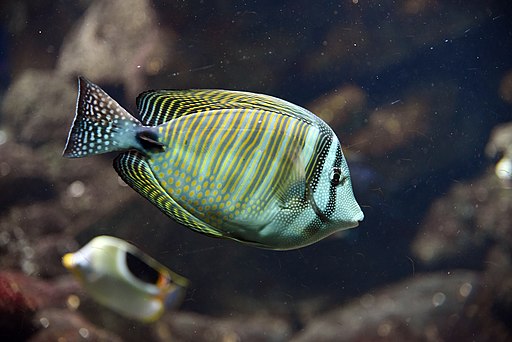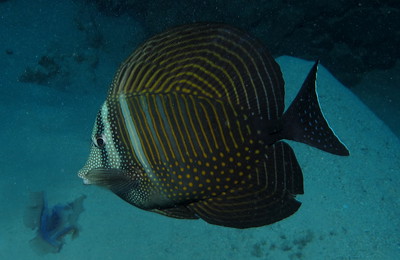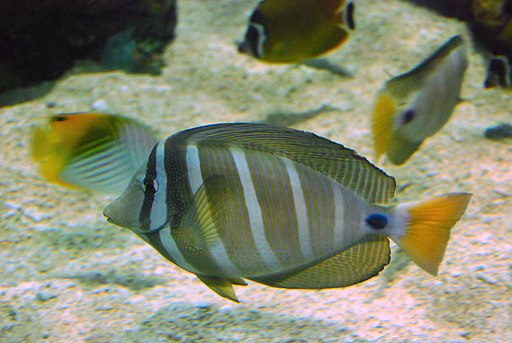Desjardini Tang: Care, Appearance, Tank Size & More
Posted by on 4/05/2023
We use affiliate links and may receive a small commission on purchases.
Known for its brilliant coloration, the Desjardini tang, also known as the Red Sea sailfin tang, is an attractive Zebrasoma species that's been making its way around aquarium circles for decades.
Caring for this species is no easy feat as you'll need a massive aquarium and a constant supply of nutrient-rich food. However, taking care of this species can also be one of the most gratifying experiences in the hobby.
In this post, we'll cover everything you'll need to know about the Desjardini tang. We'll compare its appearance with the similar Sailfin tang, recommend tank sizes, and much more.
Table of Contents
January's Giveaways on Light Fish
Species Summary
The Desjardini Tang (scientific name: Zebrasoma desjardini) is a color-changing species that falls underneath the Zebrasoma genus of fish. Only seven species exist in the genus, and all seven of them can be found in the Indian and Pacific Oceans.
The Desjardini species is quite widespread, being found in the Red Sea, off the coasts of South Africa, and further east along the reefs of Indonesia.
Similar to other Zebrasoma species, the Desjardini tang is capable of changing color within seconds. While some fish may take on a pale coloration when under some form of stress, the Desjardini changes color almost at random, with no discernable reason as to why.

Appearance
The Desjardini tang ranks high on many hobbyists' lists of favorite tang fish, largely due to its unique appearance. The fish is quite large, and with its fins fully extended, can easily reach over a foot in diameter. The species is known to change colors, and hobbyists will see different shades of blues, browns, and grays. The fish's dark bands are also capable of varying in color intensity, adding to this fish's chameleon-like behavior.
The fish's face tends to be a bit paler and is covered in a small, dot-like pattern. The body of the fish showcases large, vertical bands that extend onto the fish's dorsal, pelvic, and anal fins, all of which are quite large when fully extended. The fish's tail will display a dot-like pattern that matches the face, while its pectoral fins remain mostly translucent.
Similar to other Zebrasoma, the Desjardini has a dark spine near its caudal peduncle, which it will use to ward off any potential predators.

Sailfin Tang vs Desjardini
Similar in appearance, is the Sailfin Tang (scientific name: Zebrasoma velifer). While this species is less commonly found in home aquariums, it does get mistaken for the Desjardini tang from time to time.
You'll want to examine the fish's patterns to spot the difference between the two. The sailfin tang will have thicker vertical bands, often white and yellow. The Desjardini tang will have narrower vertical bands that tend to show an orange coloration of varying intensity.

Juvenile vs Adult
Juvenile desjardini tangs tend to have a more yellow coloration when compared to their adult counterparts. They'll be much smaller in size and will have a dotted pattern on their tails similar to adult versions of the fish.
This same technique can be used to determine the gender of any Zebrasoma species.
Male vs Female
Hobbyists looking to distinguish males from females should examine their tail scalpels. Males will have smaller spikes near the scalpel, while the skin near females will remain smooth.
This same technique can be used to determine the gender of any Zebrasoma species.
Size
Adult Desjardini tangs can grow to reach a whopping 16 inches in length.
The Desjardini tang is a massive fish, with large dorsal and anal fins that match the size of the fish's body. It comes as no surprise that hobbyists will need a large aquarium to care for such an immense species.
Desjardini Tang Care
Caring for a Desjardini tang comes with its own set of unique challenges. Due to their size, you'll need a large aquarium, with often expensive equipment rated for its size. Luckily, once you've made it past setting up an appropriate tank, the Desjardini tangs care requirements aren't much different than many other marine aquarium fish.
We'll want to re-create the Desjardini Tang's natural habitat as closely as possible. Thankfully, this information is well-researched, making care possible for the at-home hobbyist.
Lifespan
The typical lifespan of a Desjardini tang is around 7 to 8 years, although certain species have been observed to survive for up to 10 years in captivity.
Providing plenty of open space and a well-balanced diet are key factors in the well-being of a Desjardini tang.
Tank Size
Due to their large size, the Desjardini tang requires a massive aquarium that's at least 180 gallons in size.
Desjardini tangs are known for their aggression and will need plenty of space to claim as their territory. The species is quite large, and its fins when fully extended can be twice the size of the fish's body.
Acclimation
The Desjardini tang should be drip acclimated, using a drip acclimation kit , into a well-established aquarium.
We strongly recommend quarantining a Desjardini tang for 4-8 weeks before introducing it into your display tank. This should give you plenty of time to spot any potential diseases, which are more commonly found on tangs such as the Desjardini.
Great caution should be used if you plan on adding a Desjardini tang to a tank with an existing tang (see: behavior), but you can mitigate signs of aggression by utilizing an appropriately sized acclimation box .
Water Conditions
The Desjardini tang will do best when kept in an aquarium that maintains the following water conditions:
Specific Gravity: 1.020-1.025
Temperature: 72°F-78°F
dKH: 8-12 dKH
pH: 8.1-8.4
Perform regular water tests, using a reliable test kit to prevent dangerous swings in water chemistry.
Tank Setup
Due to their large size, you'll want to provide plenty of open space for these fish to swim. You'll also want to provide plenty of live rock, which will add more surface area for algae to grow. While algae won't be their primary food source, they'll consume it regularly.
Having a sump with a refugium will add more volume to the aquarium, resulting in a more stable ecosystem. Protein skimmers will also help keep the tank clean.
Sand-based or bare-bottom tanks are suitable for a Desjardini. The fish will also appreciate plenty of flow. Desjardini tangs are quite active, and will frequently swim in the current of an adjustable powerhead .
Common Diseases
While the Desjardini's slime coat isn't nearly as thin as a powder blue tang, it's still highly susceptible to some of the more common marine fish diseases, such as Ich and Marine Velvet.
Desjardini tangs are wild-caught and may be infected without displaying symptoms. As a precaution, we strongly recommend quarantining the Desjardini tang for 8 weeks to prevent the spread of any potential diseases.
If you suspect your desjardini may have marine velvet or ich, we cover the symptoms and treatment in more detail in another one of our posts: Marine Velvet vs Ich: Similarities, Differences, Causes & Treatment.
Food & Diet
The Desjardini tang is an herbivore and should be fed a diet consisting of mysis shrimp, brine shrimp, nori, spirulina, and other meaty foods 2-3 times per day.
While the inclusion of meaty foods may seem surprising considering these fish are herbivores, they'll benefit from the extra nutrition provided by these crustaceans in captivity.
These fish will also consume any available algae, but in most cases, the nutrition provided by tank-grown algae will not be enough. Using an algae clip , you can supplement their diet with a sheet of Nori. The species will also benefit from Vitamin C supplementation.
Behavior and Temperament
The Desjardini tang is known to be quite aggressive. Once it's established itself in an aquarium, new tank additions will likely be bullied by the Desjardini.
Desjardini will also display extreme levels of aggression towards other tangs, especially those in the Zebrasoma genus. Provided a large enough aquarium, if a hobbyist is planning on adding another tang species, it should be introduced into the display tank at the same time as a Desjardini.
Compared to other aggressive tangs, such as the powder blue or blonde naso, the desjardini isn't quite as aggressive, but should still be separated from new tank additions, whether that's in an acclimation box, or by a glass divider.
They are active swimmers, and will frequently swim around the lower and middle areas of the tank in search of new food sources.
Reef Compatibility
Reef aquarists will largely benefit from the Desjardini, as it is reef-safe and a known algae eater.
They won't pick at popular LPS corals such as chalices, blastos and torches. They will also ignore anemones and SPS corals, making them an excellent choice for a reef aquarium.
Tank Mates
Desjardini are territorial fish. It's best to introduce them at the same time as any additional tank mates.
Some suitable options include:
-
Blue Chromis
While desjardini behavior does vary slightly from fish to fish, you can temporarily place them in an acclimation box to curtail aggression while introducing new tank mates.
Avoid large, aggressive species like the tessalata eel or blue spotted puffer.
If an aquarium is large enough, adding other types of tangs is a risky endeavor, but still possible. Hobbyists set on doing so should have a rehoming plan in place, as well as a glass divider or acclimation box to allow for a safe introduction. A quarantine tank with a divider may also be used to introduce new tang species.
Breeding
Unfortunately, there have been no successful attempts at breeding the Desjardini tang. However, other Zebrasoma tangs, such as the Yellow Tang, have received the captive bred designation , paving an optimistic future for hobbyists looking to attempt to breed the Desjardini.
For now, all of the Desjardini tangs we've seen in the hobby are wild-caught.
Where to Purchase
The desjardini tang can occasionally be found for sale on our marketplace.
While its appearance is often quite rare in local fish stores, we've seen the fish go up for sale on some of the large online vendors, such as LiveAquaria and Saltwaterfish.com.
Always inquire about the age and tank conditions of the fish before purchasing.
Conclusion
That wraps up our guide on the Desjardini tang. Now that you've learned about the species, do you plan on stocking your display tank with one of these in the near future?
While you’ll need a massive tank to own one, they're fascinating fish to observe in an at-home aquarium. Let us know in the comments if you're considering a Desjardini, and be sure to check out our community forum and marketplace.
January's Giveaways on Light Fish


